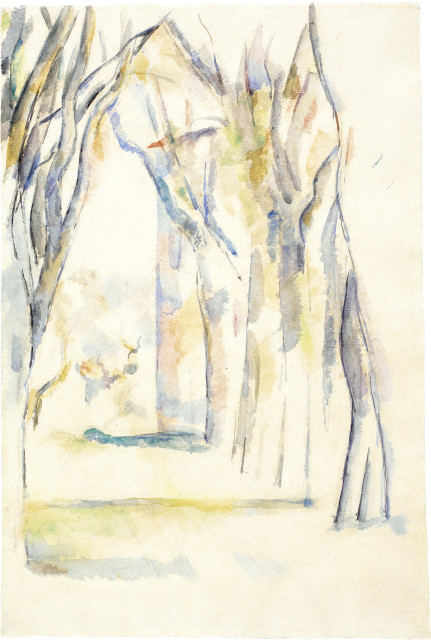- FR
S’inscrire
- Acheter
- Vendre
- Plus
- Galerie
- Commerce d'art
- Maison d'Édition
- Kornfeld aujourd’hui
- L'histoire de la Maison
- Informations



1839 Aix-en-Provence 1906
1890-1895
Watercolour over Charcoal drawing
48,7x32,8 cm, sheet size
Walter Feilchenfeldt/Jayne Warman/David Nash, Online catalogue raisonné of "The Paintings, Watercolors and Drawings of Paul Cezanne", no. FWN 1321
John Rewald, Paul Cézanne, The Watercolors, A Catalogue raisonné, Boston/London 1983, no. W 321
Lionello Venturi, Cézanne, Son art, son œuvre, Paris 1936, no. 956
Estate of Paul Cezanne (1906)
Ambroise Vollard, Paris (1907)
Galerie Bernheim-Jeune, Paris (1907)
Alphonse Kann, Saint-Germain-en-Laye (27 January 1910)
Christian Tetzen-Lund, Copenhagen
Max Silberberg, Breslau
Auktion Graupe, Berlin, 23 March 1935, cat. no. 32, ill.
Carl Roesch, Diessenhofen (until 1979); by inheritance to
Private collection, Switzerland (until 2018)
International private collection (2019)
An amicable agreement was reached with the heirs of Greta Silberberg in 2018
Selection:
Julius Meier-Graefe, Cézanne und seine Ahnen: Faksimiles nach Aquarellen, Feder- und anderen Zeichnungen von Tintoretto, Greco, Poussin, Corot, Delacroix, Cézanne, München, Marées-Gesellschaft, R. Piper & Co., 1921, Tafel XVI
John Rewald, Léo Marschutz, Cézanne et la Provence, Le Point 4, August 1936, p. 8, ill.
Fritz Novotny, Cézanne und das Ende der wissenschaftlichen Perspektive, Wien, Anton Schroll, 1938, Liste der Motive, no. 52
Yvon Taillander, P. Cézanne, Mailand, Antonio Vallardi, 1961, p. 57
Berlin 1927, Galerie Flechtheim, Cézanne, Aquarelle und Zeichnungen - Bronzen von Edgar Degas, cat. no. 18 (tree study), als Leihgabe von Max Silberberg
München 1956, Haus der Kunst, Paul Cézanne, cat. no. 84
Zürich 1956, Kunsthaus, Paul Cézanne, cat. no. 109
On cream-colored laid paper "S A V" (Société Anonyme des papeteries de Vidalon) with the ornamental knot as a watermark, minimally browned. In clean condition
Paul Cezanne has captured the dreamy chestnut avenue in the country house “Bastide du Jas de Bouffan” in Aix-en-Provence several times in impressive works. The estate was owned by the family from 1859 to 1899, and the artist also set up a studio there. Cezanne's concern not to “copy” an object or a landscape, but to “realize” the “sensation optique”, that is, the sensation of contemplation, to artistically reproduce, can be discovered perfectly in the watercolor offered here. Without leaves, probably painted in winter, the avenue is completely reduced, in an impressionistic manner. You can already feel Cezanne's importance and influence for the art of the 20th century. The fact that the watercolor appeared in Julius Meier-Graefes' facsimile portfolio as early as 1921 underlines the importance of the sheet. We thank Fabienne Ruppen for further information on the work
1890-1895
Aquarell über Kohle
48,7x32,8 cm, Blattgrösse
Walter Feilchenfeldt/Jayne Warman/David Nash, Online catalogue raisonné of "The Paintings, Watercolors and Drawings of Paul Cezanne",
John Rewald, Paul Cézanne, The Watercolors, A Catalogue raisonné, Boston/London 1983,
Lionello Venturi, Cézanne, Son art, son œuvre, Paris 1936,
Nachlass Paul Cezanne (1906)
Ambroise Vollard, Paris (1907)
Galerie Bernheim-Jeune, Paris (1907)
Alphonse Kann, Saint-Germain-en-Laye (27. Januar 1910)
Christian Tetzen-Lund, Kopenhagen
Max Silberberg, Breslau
Auktion Graupe, Berlin, 23.03.1935,
Carl Roesch, Diessenhofen (bis 1979); durch Erbschaft an
Privatsammlung Schweiz (bis 2018)
Internationale Privatsammlung (2019)
Es wurde 2018 eine gütliche Einigung mit den Erben von Greta Silberberg erzielt
Auswahl:
Julius Meier-Graefe, Cézanne und seine Ahnen: Faksimiles nach Aquarellen, Feder- und anderen Zeichnungen von Tintoretto, Greco, Poussin, Corot, Delacroix, Cézanne, München, Marées-Gesellschaft, R. Piper & Co., 1921, Tafel XVI
John Rewald, Léo Marschutz, Cézanne et la Provence, Le Point 4, August 1936, pag. 8, reprod.
Fritz Novotny, Cézanne und das Ende der wissenschaftlichen Perspektive, Wien, Anton Schroll, 1938, Liste der Motive,
Yvon Taillander, P. Cézanne, Mailand, Antonio Vallardi, 1961, pag. 57
Berlin 1927, Galerie Flechtheim, Cézanne, Aquarelle und Zeichnungen - Bronzen von Edgar Degas,
München 1956, Haus der Kunst, Paul Cézanne,
Zürich 1956, Kunsthaus, Paul Cézanne,
Auf cremefarbenem Bütten "S A V" (Société Anonyme des papeteries de Vidalon) mit dem Ornamentknoten als Wasserzeichen, minim gebräunt. In sauberer Erhaltung
Mehrfach hat Paul Cezanne die verträumte Kastanienallee im Landhaus “Bastide du Jas de Bouffan” in Aix-en-Provence in eindrücklichen Werken festgehalten. Das Gut war 1859-1899 im Familienbesitz, der Künstler hat sich dort auch ein Atelier eingerichtet. Cezannes Anliegen, nicht einen Gegenstand oder eine Landschaft zu “kopieren”, sondern die “sensation optique”, also die Empfindung der Betrachtung, künstlerisch wiederzugeben, zu “realisieren”, lässt sich im hier angebotenen Aquarell trefflich ablesen. Ohne Laub, wohl im Winter gemalt, offenbart sich die Allee völlig reduziert, in impressionistischer Manier. Man spürt darin bereits Cezannes Wichtigkeit und Einfluss für die Kunst des 20. Jahrhunderts. Dass das Aquarell schon 1921 in Julius Meier-Graefes Faksimile-Mappe erschienen ist, unterstreicht die Importanz des Blattes. Wir danken Fabienne Ruppen für weiterführende Informationen zum Werk




